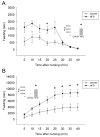Maternal high-fat diet increases independent feeding in pre-weanling rat pups
- PMID: 26873412
- PMCID: PMC4783274
- DOI: 10.1016/j.physbeh.2016.02.010
Maternal high-fat diet increases independent feeding in pre-weanling rat pups
Abstract
In laboratory settings, the adult offspring of rodent dams that are maintained on high-fat diet (HFD) before conception and/or during pregnancy/lactation display an increased incidence of obese phenotypic markers, including increased body weight and adiposity, reduced leptin sensitivity, and impaired glucose tolerance. In rat pups raised by dams consuming HFD, these obese markers emerge during the first postnatal week. Since the week-old offspring of HFD dams consume excess amounts of milk during experimental tests of independent feeding (i.e., intake away from the dam), we hypothesized that maternal diet affects suckling and/or independent ingestion by pups in the home-cage environment. In the present study, this hypothesis was tested by conducting detailed analyses of ingestive behaviors expressed by pups in the home cage. Pups raised by dams consuming HFD displayed an earlier onset of independent feeding and more amounts of calorie intake from solid food during the third postnatal week compared to pups raised by dams consuming regular chow, with no diet-related differences in suckling behavior. Independent ingestion by pups in both diet groups was most frequently observed after nursing, with offspring of HFD dams engaged more frequently in post-nursing independent feeding episodes compared to offspring of chow-fed dams, particularly when the prior nursing episode was nutritive (i.e., including milk receipt by pups). We conclude that early-life exposure to HFD enhances the facilitative effect of nutritive suckling on independent feeding in pups, promoting increased caloric intake from solid food in the home-cage environment.
Keywords: High-fat diet; Independent feeding; Nursing; Obesity; Offspring; Suckling.
Copyright © 2016 Elsevier Inc. All rights reserved.
Figures









Similar articles
-
Maternal stress and high-fat diet effect on maternal behavior, milk composition, and pup ingestive behavior.Physiol Behav. 2011 Sep 1;104(3):474-9. doi: 10.1016/j.physbeh.2011.05.012. Epub 2011 May 13. Physiol Behav. 2011. PMID: 21605577 Free PMC article.
-
Maternal high-fat diet during gestation or suckling differentially affects offspring leptin sensitivity and obesity.Diabetes. 2012 Nov;61(11):2833-41. doi: 10.2337/db11-0957. Epub 2012 Jun 29. Diabetes. 2012. PMID: 22751689 Free PMC article.
-
Delayed physical and neurobehavioral development and increased aggressive and depression-like behaviors in the rat offspring of dams fed a high-fat diet.Int J Dev Neurosci. 2013 Dec;31(8):731-9. doi: 10.1016/j.ijdevneu.2013.09.001. Epub 2013 Sep 23. Int J Dev Neurosci. 2013. PMID: 24071008 Clinical Trial.
-
Repercussions of maternal exposure to high-fat diet on offspring feeding behavior and body composition: a systematic review.J Dev Orig Health Dis. 2021 Apr;12(2):220-228. doi: 10.1017/S2040174420000318. Epub 2020 Apr 27. J Dev Orig Health Dis. 2021. PMID: 33754967
-
Vitamin A Supplementation during Suckling and Postweaning Periods Attenuates the Adverse Metabolic Effects of Maternal High-Fat Diet Consumption in Sprague-Dawley Rats.Curr Dev Nutr. 2020 Jun 27;4(8):nzaa111. doi: 10.1093/cdn/nzaa111. eCollection 2020 Aug. Curr Dev Nutr. 2020. PMID: 32734136 Free PMC article. Review.
Cited by
-
Maternal obesity during lactation may protect offspring from high fat diet-induced metabolic dysfunction.Nutr Diabetes. 2018 Apr 25;8(1):18. doi: 10.1038/s41387-018-0027-z. Nutr Diabetes. 2018. PMID: 29695710 Free PMC article.
-
Postnatal feeding with high-fat diet induces obesity and precocious puberty in C57BL/6J mouse pups: a novel model of obesity and puberty.Front Med. 2017 Jun;11(2):266-276. doi: 10.1007/s11684-017-0530-y. Epub 2017 May 13. Front Med. 2017. PMID: 28500430
-
Maternal Obesity during Pregnancy Alters Daily Activity and Feeding Cycles, and Hypothalamic Clock Gene Expression in Adult Male Mouse Offspring.Int J Mol Sci. 2019 Oct 30;20(21):5408. doi: 10.3390/ijms20215408. Int J Mol Sci. 2019. PMID: 31671625 Free PMC article.
-
Rat offspring's microbiota composition is predominantly shaped by the postnatal maternal diet rather than prenatal diet.Physiol Behav. 2023 Jan 1;258:113987. doi: 10.1016/j.physbeh.2022.113987. Epub 2022 Oct 2. Physiol Behav. 2023. PMID: 36198343 Free PMC article.
-
Diabetic vasculopathy: macro and microvascular injury.Curr Pathobiol Rep. 2020 Mar;8(1):1-14. doi: 10.1007/s40139-020-00205-x. Epub 2020 Jan 27. Curr Pathobiol Rep. 2020. PMID: 32655983 Free PMC article.
References
-
- Luppino FS, de Wit LM, Bouvy PF, Stijnen T, Cuijpers P, Penninx BWJH, et al. Overweight, obesity, and depression: A systematic review and meta-analysis of longitudinal studies. Arch Gen Psychiatry. 2010;67:220–9. - PubMed
-
- Taylor PD, Poston L. Developmental programming of obesity in mammals. Exp Physiol. 2007;92:287–98. - PubMed
-
- World Health Organization. Obesity: preventing and managing the global epidemic. 894. World Health Organization; 2000. - PubMed
-
- James PT, Leach R, Kalamara E, Shayeghi M. The worldwide obesity epidemic. Obes Res. 2001;9:228S–33S. - PubMed
Publication types
MeSH terms
Grants and funding
LinkOut - more resources
Full Text Sources
Other Literature Sources
Medical

